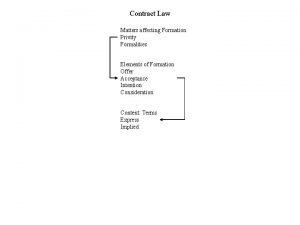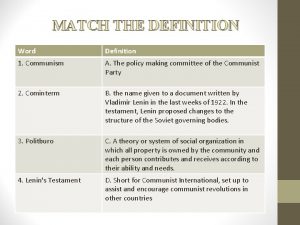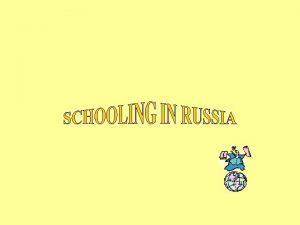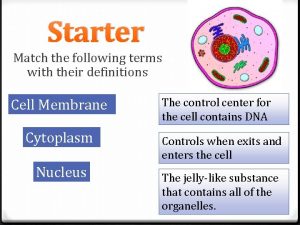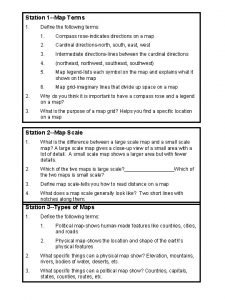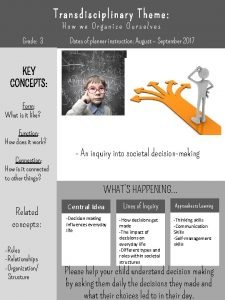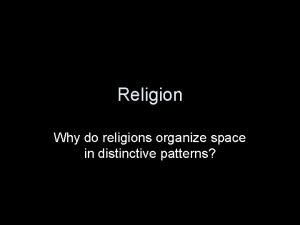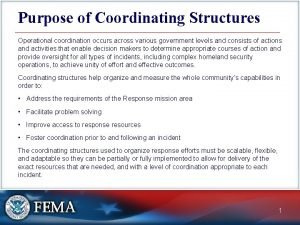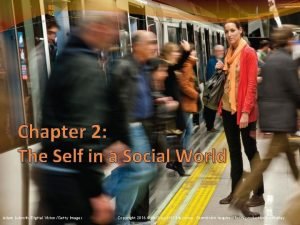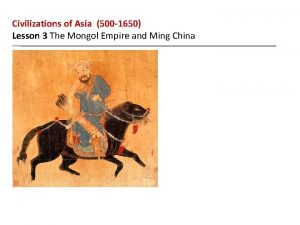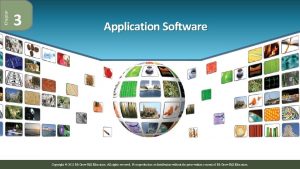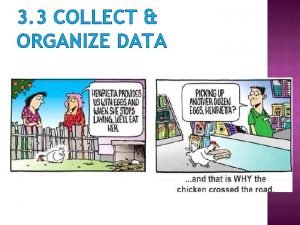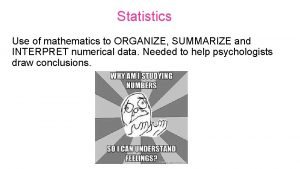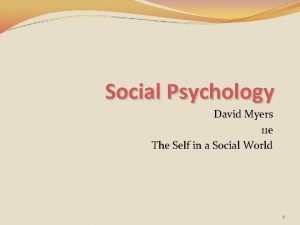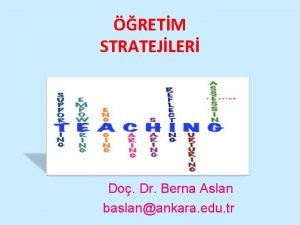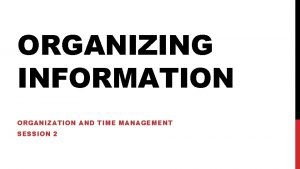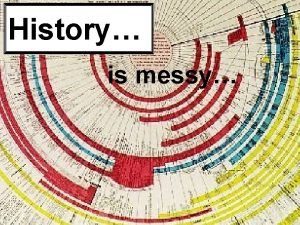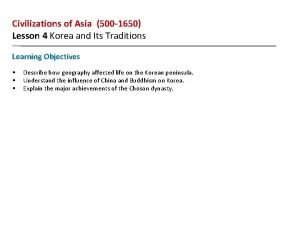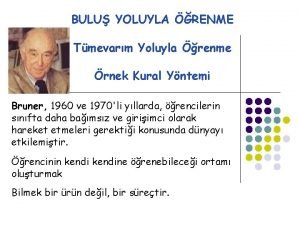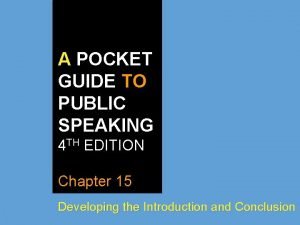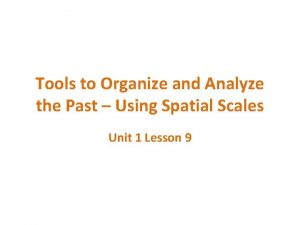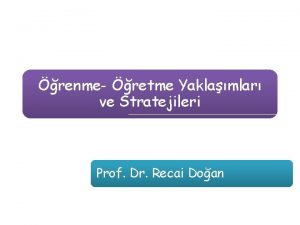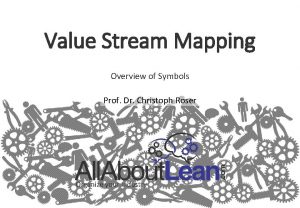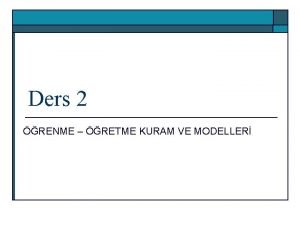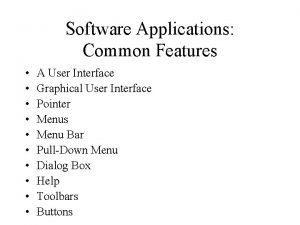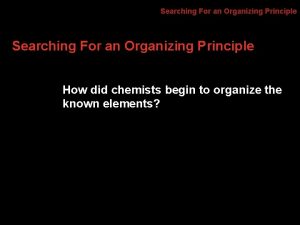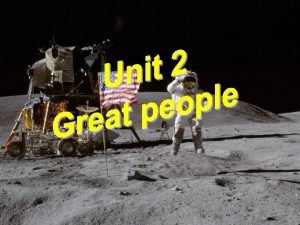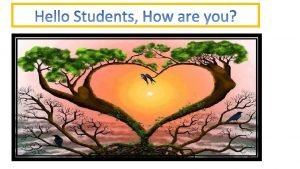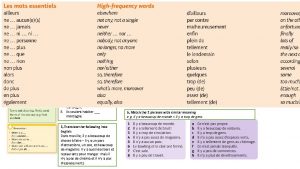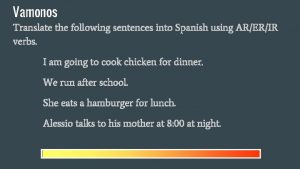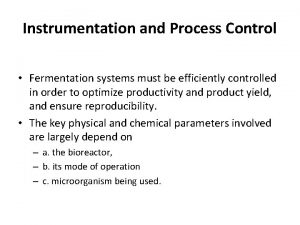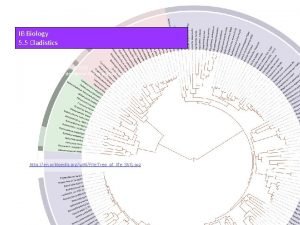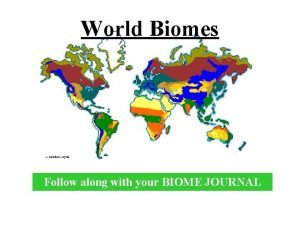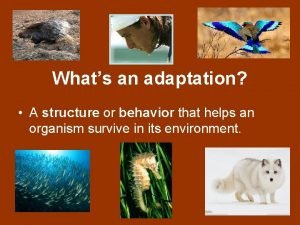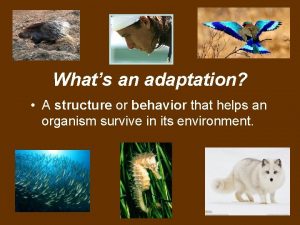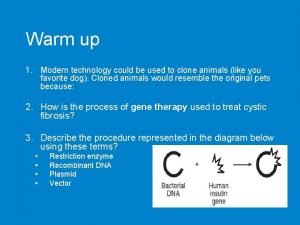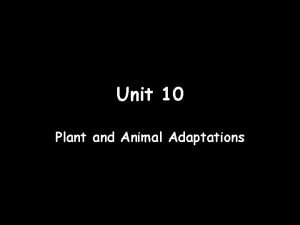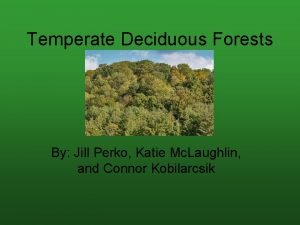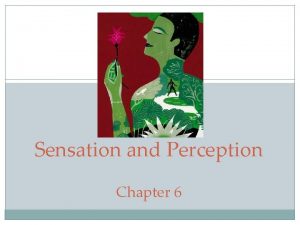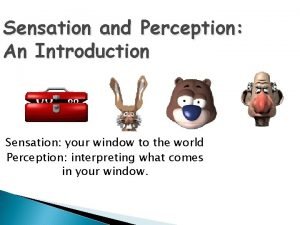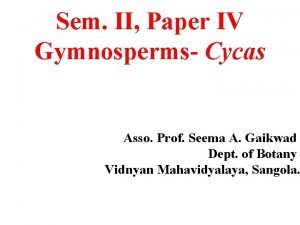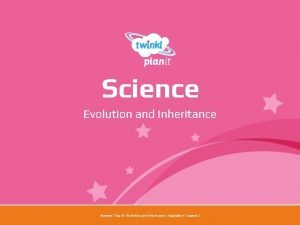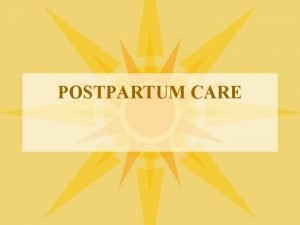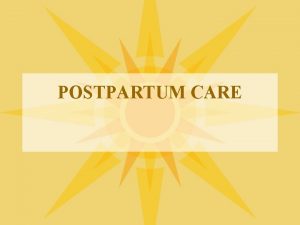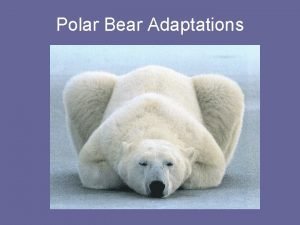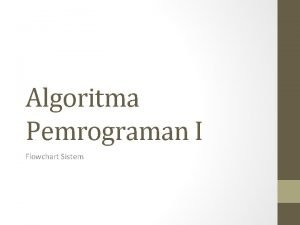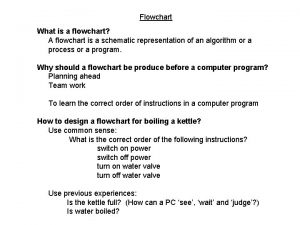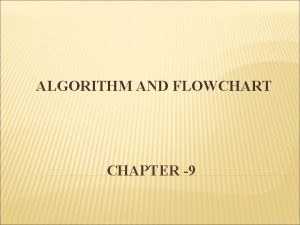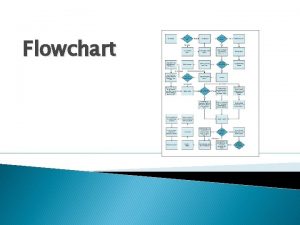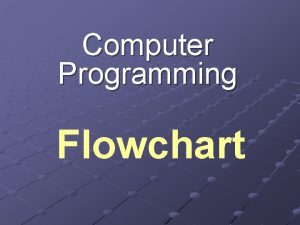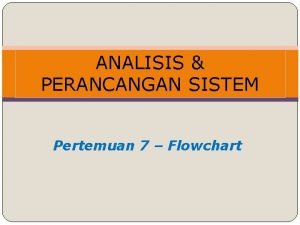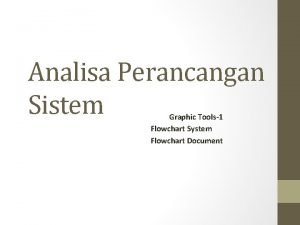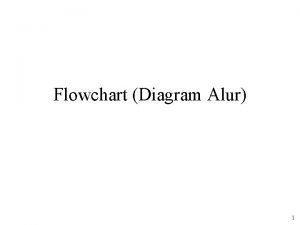Organize the following terms into a flowchart Adaptation






























































































































- Slides: 126

Organize the following terms into a flowchart • Adaptation, Environmental Change, Natural Selection, Species Changes, Variation exists

Natural Selection = only mechanism that gives consistent Adaptive Evolution • Relative fitness? • 3 ways that it can affect phenotype distribution – name and draw

What are the 2 main causes of genetic variation? • Microevolution = • Population =

5 conditions of Hardy-Weinberg Equilibrium? Is it realistic?

How we get the 2 equations

Essential knowledge 1. A. 1: Natural selection is a major mechanism of evolution. a. According to Darwin’s theory of natural selection, competition for limited resources results in differential survival. Individuals with more favorable phenotypes are more likely to survive and produce more offspring, thus passing traits to subsequent generations. b. Evolutionary fitness is measured by reproductive success. c. Genetic variation and mutation play roles in natural selection. A diverse gene pool is important for the survival of a species in a changing environment. d. Environments can be more or less stable or fluctuating, and this affects evolutionary rate and direction; different genetic variations can be selected in each generation.

e. An adaptation is a genetic variation that is favored by selection and is manifested as a trait that provides an advantage to an organism in a particular environment. f. In addition to natural selection, chance and random events can influence the evolutionary process, especially for small populations. g. Conditions for a population or an allele to be in Hardy-Weinberg equilibrium are: (1) a large population size, (2) absence of migration, (3) no net mutations, (4) random mating and (5) absence of selection. These conditions are seldom met. h. Mathematical approaches are used to calculate changes in allele frequency, providing evidence for the occurrence of evolution in a population. To foster student understanding of this concept, instructors can choose an illustrative example such as: • Graphical analysis of allele frequencies in a population • Application of the Hardy-Weinberg equilibrium equation

Learning Objectives LO 1. 1 The student is able to convert a data set from a table of numbers that reflect a change in the genetic makeup of a population over time and to apply mathematical methods and conceptual understandings to investigate the cause(s) and effect(s) of this change. [See SP 1. 5, 2. 2] LO 1. 2 The student is able to evaluate evidence provided by data to qualitatively and quantitatively investigate the role of natural selection in evolution. [See SP 2. 2, 5. 3] LO 1. 3 The student is able to apply mathematical methods to data from a real or simulated population to predict what will happen to the population in the future. [See SP 2. 2]


Essential knowledge 1. A. 2: Natural selection acts on phenotypic variations in populations. a. Environments change and act as selective mechanism on populations. To foster student understanding of this concept, instructors can choose an illustrative example such as: • Flowering time in relation to global climate change • Peppered moth b. Phenotypic variations are not directed by the environment but occur through random changes in the DNA and through new gene combinations.

Peppered Moths, Variation, and the Industrial Revolution – Find the moths in the pictures Let’s graph allele frequencies over time


c. Some phenotypic variations significantly increase or decrease fitness of the organism and the population. To foster student understanding of this concept, instructors can choose an illustrative example such as: • Sickle cell anemia • Peppered moth • DDT resistance in insects d. Humans impact variation in other species. To foster student understanding of this concept, instructors can choose an illustrative example such as: • Artificial selection • Loss of genetic diversity within a crop species • Overuse of antibiotics

Genetic variation preserved how? • Why not perfection?

Learning Objectives • LO 1. 4 The student is able to evaluate data-based evidence that describes evolutionary changes in the genetic makeup of a population over time. [See SP 5. 3] • LO 1. 5 The student is able to connect evolutionary changes in a population over time to a change in the environment. [See SP 7. 1]

Essential knowledge 1. A. 3: Evolutionary change is also driven by random processes. a. Genetic drift is a nonselective process occurring in small populations. b. Reduction of genetic variation within a given population can increase the differences between populations of the same species.

What is genetic drift? Give 2 examples

Learning Objectives LO 1. 6 The student is able to use data from mathematical models based on the Hardy-Weinberg equilibrium to analyze genetic drift and effects of selection in the evolution of specific populations. [See SP 1. 4, 2. 1] LO 1. 7 The student is able to justify data from mathematical models based on the Hardy-Weinberg equilibrium to analyze genetic drift and the effects of selection in the evolution of specific populations. [See SP 2. 1] LO 1. 8 The student is able to make predictions about the effects of genetic drift, migration and artificial selection on the genetic makeup of a population. [See SP 6. 4]

List as many categories of Evidence of Evolution as you can

Essential knowledge 1. A. 4: Biological evolution is supported by scientific evidence from many disciplines, including mathematics. a. Scientific evidence of biological evolution uses information from geographical, geological, physical, chemical and mathematical applications. b. Molecular, morphological and genetic information of existing and extinct organisms add to our understanding of evolution. Evidence of student learning is a demonstrated understanding of eachof the following: 1. Fossils can be dated by a variety of methods that provide evidence for evolution. These include the age of the rocks where a fossil is found, the rate of decay of isotopes including carbon-14, the relationships within phylogenetic trees, and the mathematical calculations that take into account information from chemical properties and/or geographical data. ✘✘ The details of these methods are beyond the scope of this course and the AP Exam.

2. Morphological homologies represent features shared by common ancestry. Vestigial structures are remnants of functional structures, which can be compared to fossils and provide evidence for evolution. 3. Biochemical and genetic similarities, in particular DNA nucleotide and protein sequences, provide evidence for evolution and ancestry. 4. Mathematical models and simulations can be used to illustrate and support evolutionary concepts. To foster student understanding of this concept, instructors can choose an illustrative example such as: • Graphical analyses of allele frequencies in a population • Analysis of sequence data sets • Analysis of phylogenetic trees • Construction of phylogenetic trees based on sequence data

How Rocks and Fossils Are Dated • Sedimentary strata reveal the relative ages of fossils • The absolute ages of fossils can be determined by radiometric dating • A “parent” isotope decays to a “daughter” isotope at a constant rate • Each isotope has a known half-life, the time required for half the parent isotope to decay • Radiocarbon dating can be used to date fossils up to 75, 000 years old • For older fossils, some isotopes can be used to date sedimentary rock layers above and below the fossil © 2011 Pearson Education, Inc.

Fraction of parent isotope remaining Figure 25. 5 1 2 Remaining “parent” isotope 1 Accumulating “daughter” isotope 1 4 1 2 3 Time (half-lives) 8 1 4 16

Figure 26. 8 -4 1 1 2 Deletion 2 Systematists use 1 computer programs and 2 mathematical tools when analyzing comparable DNA segments from different organisms 3 1 2 4 1 2 Insertion

Sorting Homology from Analogy • When constructing a phylogeny, systematists need to distinguish whether a similarity is the result of homology or analogy • Homology is similarity due to shared ancestry • Analogy is similarity due to convergent evolution • Convergent evolution occurs when similar environmental pressures and natural selection produce similar (analogous) adaptations in organisms from different evolutionary lineages • Bat and bird wings are homologous as forelimbs, but analogous as functional wings © 2011 Pearson Education, Inc.

Learning Objectives LO 1. 9 The student is able to evaluate evidence provided by data from many scientific disciplines that support biological evolution. [See SP 5. 3] LO 1. 10 The student is able to refine evidence based on data from many scientific disciplines that support biological evolution. [See SP 5. 2] LO 1. 11 The student is able to design a plan to answer scientific questions regarding how organisms have changed over time using information from morphology, biochemistry and geology. [See SP 4. 2] LO 1. 12 The student is able to connect scientific evidence from many scientific disciplines to support the modern concept of evolution. [See SP 7. 1] LO 1. 13 The student is able to construct and/or justify mathematical models, diagrams or simulations that represent processes of biological evolution. [See SP 1. 1, 2. 1]

L. O. 1. 13

Essential knowledge 1. B. 1: Organisms share many conserved core processes and features that evolved and are widely distributed among organisms today. a. Structural and functional evidence supports the relatedness of all domains. Evidence of student learning is a demonstrated understanding of each of the following: 1. DNA and RNA are carriers of genetic information through transcription, translation and replication. [See also 3. A. 1 ] 2. Major features of the genetic code are shared by all modern living systems. [See also 3. A. 1] 3. Metabolic pathways are conserved across all currently recognized domains. [See also 3. D. 1]

b. Structural evidence supports the relatedness of all eukaryotes. [See also 2. B. 3, 4. A. 2] To foster student understanding of this concept, instructors can choose an illustrative example such as: • Cytoskeleton (a network of structural proteins that facilitate cell movement, morphological integrity and organelle transport) • Membrane-bound organelles (mitochondria and/or chloroplasts) • Linear chromosomes • Endomembrane systems, including the nuclear envelope

Learning Objectives LO 1. 14 The student is able to pose scientific questions that correctly identify essential properties of shared, core life processes that provide insights into the history of life on Earth. [See SP 3. 1] LO 1. 15 The student is able to describe specific examples of conserved core biological processes and features shared by all domains or within one domain of life, and how these shared, conserved core processes and features support the concept of common ancestry for all organisms. [See SP 7. 2] LO 1. 16 The student is able to justify the scientific claim that organisms share many conserved core processes and features that evolved and are widely distributed among organisms today. [See SP 6. 1]

L. O. 1. 15

Essential knowledge 1. B. 2: Phylogenetic trees and cladograms are graphical representations (models) of evolutionary history that can be tested. a. Phylogenetic trees and cladograms can represent traits that are either derived or lost due to evolution. To foster student understanding of this concept, instructors can choose an illustrative example such as: • Number of heart chambers in animals • Opposable thumbs • Absence of legs in some sea mammals b. Phylogenetic trees and cladograms illustrate speciation that has occurred, in that relatedness of any two groups on the tree is shown by how recently two groups had a common ancestor.

Figure 22. 20 Other even-toed ungulates Hippopotamuses †Pakicetus †Rodhocetus Common ancestor of cetaceans †Dorudon Living cetaceans 70 60 50 40 30 20 Millions of years ago 10 0 Key Pelvis Femur Tibia Foot

c. Phylogenetic trees and cladograms can be constructed from morphological similarities of living or fossil species, and from DNA and protein sequence similarities, by employing computer programs that have sophisticated ways of measuring and representing relatedness among organisms. d. Phylogenetic trees and cladograms are dynamic (i. e. , phylogenetic trees and cladograms are constantly being revised), based on the biological data used, new mathematical and computational ideas, and current and emerging knowledge.

Learning Objectives LO 1. 17 The student is able to pose scientific questions about a group of organisms whose relatedness is described by a phylogenetic tree or cladogram in order to (1) identify shared characteristics, (2) make inferences about the evolutionary history of the group, and (3) identify character data that could extend or improve the phylogenetic tree. [See SP 3. 1] LO 1. 18 The student is able to evaluate evidence provided by a data set in conjunction with a phylogenetic tree or a simple cladogram to determine evolutionary history and speciation. [See SP 5. 3] LO 1. 19 The student is able create a phylogenetic tree or simple cladogram that correctly represents evolutionary history and speciation from a provided data set. [See SP 1. 1]

Classification terms • Phylogeny = – Inferred from homologous structures and molecular data • Systematics = • Taxonomy = – Binomial nomenclature – DKPCOFGS – look at table of 3 domains – Taxon • Phlyogenetic Tree • Cladogram and clades

Figure 26. 3 Species: Panthera pardus Genus: Panthera Family: Felidae Order: Carnivora Class: Mammalia Phylum: Chordata Domain: Bacteria Kingdom: Animalia Domain: Eukarya Domain: Archaea

Figure 26. 10 • A valid clade is monophyletic, signifying that it consists of the ancestor species and all its descendants (a) Monophyletic group (clade) (b) Paraphyletic group (c) Polyphyletic group A A B B C C C D D D E E F F F G G G A B Group E Group

Figure 26. 5 Branch point: where lineages diverge Taxon A Taxon B Taxon C Sister taxa Taxon D ANCESTRAL LINEAGE Taxon F Taxon G This branch point represents the common ancestor of taxa A–G. This branch point forms a polytomy: an unresolved pattern of divergence. Basal taxon

L. O. 1. 19



Speciation – when does evolution result in a new species? • Species defined = • Macroevolution = • What are 2 main types of reproductive isolation?

Figure 24. 3_a Prezygotic barriers Habitat Isolation Temporal Isolation (a) Gametic Isolation Mechanical Isolation Behavioral Isolation Individuals of different species Postzygotic barriers MATING ATTEMPT (c) (d) (e) Reduced Hybrid Viability Reduced Hybrid Fertility Hybrid Breakdown VIABLE, FERTILE OFFSPRING FERTILIZATION (f) (g) (h) (i) (j) (b) (k) (l)

Prezygotic vs. Postzygotic • Describe various methods of prezygotic: isolation: habitat, behavioral, temporal, mechanical, gametic • Describe various methods of postzygotic: Reduced hybrid viability, Reduced hybrid fertility, Hybrid breakdown

Allopatric vs. Sympatric speciation – has to do with geographic isolation • Allopatric: • Sympatric:

Figure 24. 14 -4 Hybrid Zones Possible outcomes: Isolated population diverges Hybrid zone Reinforcement OR Fusion Gene flow Population OR Barrier to gene flow Hybrid individual Stability

Figure 24. 4 Grizzly bear (U. arctos) Polar bear (U. maritimus) Fusion may lead to extinction of the polar bear Hybrid “grolar bear”

Speed of Speciation • Gradualism • Punctuated Equilibrium & Adaptive radiation

Essential knowledge 1. C. 1: Speciation and extinction have occurred throughout the Earth’s history. a. Speciation rates can vary, especially when adaptive radiation occurs when new habitats become available. b. Species extinction rates are rapid at times of ecological stress. [See also 4. C. 3] To foster student understanding of this concept, instructors can choose an illustrative example such as: • Five major extinctions • Human impact on ecosystems and species extinction rates ✘✘ The names and dates of these extinctions are beyond the scope of this course and the AP Exam.

Learning Objectives LO 1. 20 The student is able to analyze data related to questions of speciation and extinction throughout the Earth’s history. [See SP 5. 1] LO 1. 21 The student is able to design a plan for collecting data to investigate the scientific claim that speciation and extinction have occurred throughout the Earth’s history. [See SP 4. 2]

L. O. 1. 21

Essential knowledge 1. C. 2: Speciation may occur when two populations become reproductively isolated from each other. a. Speciation results in diversity of life forms. Species can be physically separated by a geographic barrier such as an ocean or a mountain range, or various pre-and post-zygotic mechanisms can maintain reproductive isolation and prevent gene flow. b. New species arise from reproductive isolation over time, which can involve scales of hundreds of thousands or even millions of years, or speciation can occur rapidly through mechanisms such as polyploidy in plants.

Learning Objectives LO 1. 22 The student is able to use data from a real or simulated population(s), based on graphs or models of types of selection, to predict what will happen to the population in the future. [See SP 6. 4] LO 1. 23 The student is able to justify the selection of data that address questions related to reproductive isolation and speciation. [See SP 4. 1] LO 1. 24 The student is able to describe speciation in an isolated population and connect it to change in gene frequency, change in environment, natural selection and/or genetic drift. [See SP 7. 2]

Essential knowledge 1. C. 3: Populations of organisms continue to evolve. a. Scientific evidence supports the idea that evolution has occurred in all species. b. Scientific evidence supports the idea that evolution continues to occur. To foster student understanding of this concept, instructors can choose an illustrative example such as: • Chemical resistance (mutations for resistance to antibiotics, pesticides, herbicides or chemotherapy drugs occur in the absence of the chemical) • Emergent diseases • Observed directional phenotypic change in a population (Grants’ observations of Darwin’s finches in the Galapagos) • A eukaryotic example that describes evolution of a structure or process such as heart chambers, limbs, the brain and the immune system

Learning Objectives LO 1. 25 The student is able to describe a model that represents evolution within a population. [See SP 1. 2] LO 1. 26 The student is able to evaluate given data sets that illustrate evolution as an ongoing process. [See SP 5. 3]

Essential knowledge 1. D. 1: There are several hypotheses about the natural origin of life on Earth, each with supporting scientific evidence. a. Scientific evidence supports the various models. Evidence of student learning is a demonstrated understanding of each of the following: 1. Primitive Earth provided inorganic precursors from which organic molecules could have been synthesized due to the presence of available free energy and the absence of a significant quantity of oxygen. 2. In turn, these molecules served as monomers or building blocks for the formation of more complex molecules, including amino acids and nucleotides. [See also 4. A. 1] 3. The joining of these monomers produced polymers with the ability to replicate, store and transfer information. 4. These complex reaction sets could have occurred in solution (organic soup model) or as reactions on solid reactive surfaces. [See also 2. B. 1] 5. The RNA World hypothesis proposes that RNA could have been the earliest genetic material.

Learning Objectives LO 1. 27 The student is able to describe a scientific hypothesis about the origin of life on Earth. [See SP 1. 2] LO 1. 28 The student is able to evaluate scientific questions based on hypotheses about the origin of life on Earth. [See SP 3. 3] LO 1. 29 The student is able to describe the reasons for revisions of scientific hypotheses of the origin of life on Earth. [See SP 6. 3] LO 1. 30 The student is able to evaluate scientific hypotheses about the origin of life on Earth. [See SP 6. 5] LO 1. 31 The student is able to evaluate the accuracy and legitimacy of data to answer scientific questions about the origin of life on Earth. [See SP 4. 4]

Concept 25. 1: Conditions on early Earth made the origin of life possible • Chemical and physical processes on early Earth may have produced very simple cells through a sequence of stages: 1. Abiotic synthesis of small organic molecules 2. Joining of these small molecules into macromolecules 3. Packaging of molecules into protocells 4. Origin of self-replicating molecules © 2011 Pearson Education, Inc.

Early Earth • Spontaneous generation vs. biogenesis. • Although there is no evidence that spontaneous generation occurs today, conditions on the early Earth were very different. – There was very little atmospheric oxygen to attack complex molecules. – Energy sources, such as lightning, volcanic activity, and ultraviolet sunlight, were more intense than what we experience today.

Abiotic synthesis of organic molecules is a testable hypothesis • In the 1920’s, A. I. Oparin and J. B. S. Haldane independently postulated that conditions on the early Earth favored the synthesis of organic compounds from inorganic precursors. – They reasoned that this cannot happen today because high levels of oxygen in the atmosphere attack chemical bonds. Copyright © 2002 Pearson Education, Inc. , publishing as Benjamin Cummings

• In 1953, Stanley Miller and Harold Urey tested the Oparin-Haldane hypothesis by creating, in the laboratory, the conditions that had been postulated for early Earth. • They discharged sparks in an “atmosphere” of gases and water vapor. Fig. 26. 10 Copyright © 2002 Pearson Education, Inc. , publishing as Benjamin Cummings


• The Miller-Urey experiments still stimulate debate on the origin of Earth’s early stockpile of organic ingredients. – Alternate sites proposed for the synthesis of organic molecules include submerged volcanoes and deep-sea vents where hot water and minerals gush into the deep ocean. – Another possible source for organic monomers on Earth is from space, including via meteorites containing organic molecules that crashed to Earth. (Amino acids have been found in meteorites) Copyright © 2002 Pearson Education, Inc. , publishing as Benjamin Cummings

Laboratory simulations of early-Earth conditions have produced organic polymers • The abiotic origin hypothesis predicts that monomers should link to form polymers without enzymes and other cellular equipment. • Researchers have produced polymers, including polypeptides, after dripping solutions of monomers onto hot sand, clay, or rock. – Similar conditions likely existed on the early Earth when dilute solutions of monomers splashed onto fresh lava or at deep-sea vents. Copyright © 2002 Pearson Education, Inc. , publishing as Benjamin Cummings

RNA may have been the first genetic material • Life is defined partly by inheritance. • Today, cells store their genetic information as DNA, transcribe select sections into RNA, and translate the RNA messages into enzymes and other proteins. • Many researchers have proposed that the first hereditary material was RNA, not DNA. “RNA WORLD” – Because RNA can also function as an enzymes, it helps resolve the paradox of which came first, genes or enzymes.

• Short polymers of ribonucleotides can be synthesized abiotically in the laboratory. – If these polymers are added to a solution of ribonucleotide monomers, sequences up to 10 based long are copied from the template according to the base-pairing rules. – If zinc is added, the copied sequences may reach 40 nucleotides with less than 1% error. Copyright © 2002 Pearson Education, Inc. , publishing as Benjamin Cummings Fig. 26. 11

• In the 1980’s Thomas Cech discovered that RNA molecules are important catalysts in modern cells. • RNA catalysts, called ribozymes, remove introns from RNA. • Ribozymes also help catalyze the synthesis of new RNA polymers. • In the pre-biotic world, RNA molecules may have been fully capable of ribozymecatalyzed replication. Copyright © 2002 Pearson Education, Inc. , publishing as Benjamin Cummings

• RNA-directed protein synthesis may have begun as weak binding of specific amino acids to bases along RNA molecules, which functioned as simple templates holding a few amino acids together long enough for them to be linked. – This is one function of r. RNA today in ribosomes. • If RNA synthesized a short polypeptide that behaved as an enzyme helping RNA replication, then early chemical dynamics would include molecular cooperation as well as competition.

Protocells can form by self-assembly • Living cells may have been preceded by protocells, aggregates of abiotically produced molecules. • Protocells do not reproduce precisely, but they do maintain an internal chemical environment from their surroundings and may show some properties associated with life, metabolism, and excitability. Copyright © 2002 Pearson Education, Inc. , publishing as Benjamin Cummings

• In the laboratory, droplets of abiotically produced organic compounds, called liposomes, form when lipids are included in the mix. • The lipids form a molecular bilayer at the droplet surface, much like the lipid bilayer of a membrane. – These droplets can undergo osmotic swelling or shrinking in different salt concentrations. – They also store energy as a membrane potential, a voltage cross the surface. Copyright © 2002 Pearson Education, Inc. , publishing as Benjamin Cummings

• Liposomes behave dynamically, growing by engulfing smaller liposomes or “giving birth” to smaller liposomes. Fig. 26. 12 a Copyright © 2002 Pearson Education, Inc. , publishing as Benjamin Cummings

• If enzymes are included among the ingredients, they are incorporated into the droplets. • The protocells are then able to absorb substrates from their surroundings and release the products of the reactions catalyzed by the enzymes. Fig. 26. 12 b Copyright © 2002 Pearson Education, Inc. , publishing as Benjamin Cummings

Natural section could refine protocells containing hereditary information • Once primitive RNA genes and their polypeptide products were packaged within a membrane, the protocells could have evolved as units. • Molecular cooperation could be refined because favorable components were concentrated together, rather than spread throughout the surroundings. Fig. 26. 13

• As an example: suppose that an RNA molecule ordered amino acids into a primitive enzyme that extracted energy from inorganic sulfur compounds taken up from the surroundings – This energy could be used for other reactions within the protobiont, including the replication of RNA. – Natural selection would favor such a gene only if its products were kept close by, rather than being shared with competing RNA sequences in the environment. Copyright © 2002 Pearson Education, Inc. , publishing as Benjamin Cummings

• The most successful protocells would grow and split, distributing copies of their genes to offspring. • Even if only one such protocell arose initially by the abiotic processes that have been described, its descendents would vary because of mutation, errors in copying RNA. Copyright © 2002 Pearson Education, Inc. , publishing as Benjamin Cummings

• Evolution via differential reproductive success of varied individuals presumably refined primitive metabolism and inheritance. – One refinement was the replacement of RNA as the repository of genetic information by DNA, a more stable molecule. – Once DNA appeared, RNA molecules would have begun to take on their modern roles as intermediates in translation of genetic programs. Copyright © 2002 Pearson Education, Inc. , publishing as Benjamin Cummings

Essential knowledge 1. D. 2: Scientific evidence from many different disciplines supports models of the origin of life. a. Geological evidence provides support for models of the origin of life on Earth. Evidence of student learning is a demonstrated understanding of each of the following: 1. The Earth formed approximately 4. 6 billion years ago (bya), and the environment was too hostile for life until 3. 9 bya, while the earliest fossil evidence for life dates to 3. 5 bya. Taken together, this evidence provides a plausible range of dates when the origin of life could have occurred. 2. Chemical experiments have shown that it is possible to form complex organic molecules from inorganic molecules in the absence of life. b. Molecular and genetic evidence from extant and extinct organisms indicates that all organisms on Earth share a common ancestral origin of life. Evidence of student learning is a demonstrated understanding of each of the following: 1. Scientific evidence includes molecular building blocks that are common to all life forms. 2. Scientific evidence includes a common genetic code.

Animation: The Geologic Record Right-click slide / select “Play” © 2011 Pearson Education, Inc.

Cenozoic Present Figure 25. 14 a th r No 65. 5 ic er Am Eurasia Africa India South America Madagascar ralia st 135 251 Mesozoic Laurasia Paleozoic Millions of years ago Antarctica Gon dwa ng Pa a ae na Au

• Continental drift has many effects on living organisms – A continent’s climate can change as it moves north or south – Separation of land masses can lead to allopatric speciation • The distribution of fossils and living groups reflects the historic movement of continents – For example, the similarity of fossils in parts of South America and Africa is consistent with the idea that these continents were formerly attached © 2011 Pearson Education, Inc.

Mass Extinctions • The fossil record shows that most species that have ever lived are now extinct • Extinction can be caused by changes to a species’ environment • At times, the rate of extinction has increased dramatically and caused a mass extinction • Mass extinction is the result of disruptive global environmental changes © 2011 Pearson Education, Inc.

• A number of factors might have contributed to these extinctions – Intense volcanism in what is now Siberia – Global warming resulting from the emission of large amounts of CO 2 from the volcanoes – Reduced temperature gradient from equator to poles – Oceanic anoxia from reduced mixing of ocean waters © 2011 Pearson Education, Inc.

• The Cretaceous mass extinction 65. 5 million years ago separates the Mesozoic from the Cenozoic • Organisms that went extinct include about half of all marine species and many terrestrial plants and animals, including most dinosaurs © 2011 Pearson Education, Inc.

• The presence of iridium in sedimentary rocks suggests a meteorite impact about 65 million years ago • Dust clouds caused by the impact would have blocked sunlight and disturbed global climate • The Chicxulub crater off the coast of Mexico is evidence of a meteorite that dates to the same time © 2011 Pearson Education, Inc.

Figure 25. 16 NORTH AMERICA Yucatán Peninsula Chicxulub crater

Is a Sixth Mass Extinction Under Way? • Scientists estimate that the current rate of extinction is 100 to 1, 000 times the typical background rate • Extinction rates tend to increase when global temperatures increase • Data suggest that a sixth, human-caused mass extinction is likely to occur unless dramatic action is taken © 2011 Pearson Education, Inc.

Adaptive Radiations • Adaptive radiation is the evolution of diversely adapted species from a common ancestor • Adaptive radiations may follow – Mass extinctions – The evolution of novel characteristics – The colonization of new regions © 2011 Pearson Education, Inc.

Worldwide Adaptive Radiations • Mammals underwent an adaptive radiation after the extinction of terrestrial dinosaurs • The disappearance of dinosaurs (except birds) allowed for the expansion of mammals in diversity and size • Other notable radiations include photosynthetic prokaryotes, large predators in the Cambrian, land plants, insects, and tetrapods © 2011 Pearson Education, Inc.

• Clock analogy of History of Life Fig. 26. 2 Copyright © 2002 Pearson Education, Inc. , publishing as Benjamin Cummings

The First Single-Celled Organisms • The oldest known fossils are stromatolites, rocks formed by the accumulation of sedimentary layers on bacterial mats • Stromatolites date back 3. 5 billion years ago • Prokaryotes were Earth’s sole inhabitants from 3. 5 to about 2. 1 billion years ago © 2011 Pearson Education, Inc.

The First Eukaryotes • The oldest fossils of eukaryotic cells date back 2. 1 billion years • Eukaryotic cells have a nuclear envelope, mitochondria, endoplasmic reticulum, and a cytoskeleton • The endosymbiont theory proposes that mitochondria and plastids (chloroplasts and related organelles) were formerly small prokaryotes living within larger host cells • An endosymbiont is a cell that lives within a host cell © 2011 Pearson Education, Inc.

• The prokaryotic ancestors of mitochondria and plastids probably gained entry to the host cell as undigested prey or internal parasites • In the process of becoming more interdependent, the host and endosymbionts would have become a single organism • Serial endosymbiosis supposes that mitochondria evolved before plastids through a sequence of endosymbiotic events © 2011 Pearson Education, Inc.

Figure 25. 9 -3 Plasma membrane Cytoplasm DNA Ancestral prokaryote Nucleus Endoplasmic reticulum Photosynthetic prokaryote Mitochondrion Nuclear envelope Aerobic heterotrophic prokaryote Mitochondrion Ancestral heterotrophic eukaryote Plastid Ancestral photosynthetic eukaryote

• Key evidence supporting an endosymbiotic origin of mitochondria and plastids: – Inner membranes are similar to plasma membranes of prokaryotes – Division is similar in these organelles and some prokaryotes – These organelles transcribe and translate their own DNA – Their ribosomes are more similar to prokaryotic than eukaryotic ribosomes © 2011 Pearson Education, Inc.

Plants, fungi, and animals colonized the land about 500 million years ago • The colonization of land was one of the pivotal milestones in the history of life. – There is fossil evidence that cyanobacteria and other photosynthetic prokaryotes coated damp terrestrial surfaces well over a billion years ago. – However, macroscopic life in the form of plants, fungi, and animals did not colonize land until about 500 million years ago, during the early Paleozoic era. Copyright © 2002 Pearson Education, Inc. , publishing as Benjamin Cummings

• The gradual evolution from aquatic to terrestrial habitats required adaptations to prevent dehydration and to reproduce on land. – For example, plants evolved a waterproof coating of wax on the leaves to slow the loss of water. • Plants colonized land in association with fungi. – Fungi aid the absorption of water and nutrients from the soil. – The fungi obtain organic nutrients from the plant. – This ancient symbiotic association is evident in some of the oldest fossilized roots. Copyright © 2002 Pearson Education, Inc. , publishing as Benjamin Cummings

• Plants created new opportunities for all life, including herbivorous (plant-eating) animals and their predators. • The most widespread and diverse terrestrial animals are certain arthropods (including insects and spiders) and certain vertebrates (including amphibians, reptiles, birds, and mammals). Copyright © 2002 Pearson Education, Inc. , publishing as Benjamin Cummings

• The terrestrial vertebrates, called tetrapods because of their four walking limbs, evolved from fishes, based on an extensive fossil record. – Reptiles evolved from amphibians, both birds and mammals evolved from reptiles. • Most orders of modern mammals, including primates, appeared 50 -60 million years ago. • Humans diverged from other primates only 5 million years ago. Copyright © 2002 Pearson Education, Inc. , publishing as Benjamin Cummings

Learning Objectives LO 1. 32 The student is able to justify the selection of geological, physical, and chemical data that reveal early Earth conditions. [See SP 4. 1]

Essential knowledge 2. E. 1: Timing and coordination of specific events are necessary for the normal development of an organism, and these events are regulated by a variety of mechanisms. a. Observable cell differentiation results from the expression of genes for tissue-specific proteins. b. Induction of transcription factors during development results in sequential gene expression. Evidence of student learning is a demonstrated understanding of each of the following: 1. Homeotic genes are involved in developmental patterns and sequences. 2. Embryonic induction in development results in the correct timing of events. 3. Temperature and the availability of water determine seed germination in most plants. 4. Genetic mutations can result in abnormal development. 5. Genetic transplantation experiments support the link between gene expression and normal development. 6. Genetic regulation by micro. RNAs plays an important role in the development of organisms and the control of cellular functions.

Concept 25. 5: Major changes in body form can result from changes in the sequences and regulation of developmental genes • Studying genetic mechanisms of change can provide insight into large-scale evolutionary change © 2011 Pearson Education, Inc.

Changes in Rate and Timing • Heterochrony is an evolutionary change in the rate or timing of developmental events • It can have a significant impact on body shape • The contrasting shapes of human and chimpanzee skulls are the result of small changes in relative growth rates © 2011 Pearson Education, Inc.

Changes in Spatial Pattern • Substantial evolutionary change can also result from alterations in genes that control the placement and organization of body parts • Homeotic genes determine such basic features as where wings and legs will develop on a bird or how a flower’s parts are arranged © 2011 Pearson Education, Inc.

• Hox genes are a class of homeotic genes that provide positional information during development • If Hox genes are expressed in the wrong location, body parts can be produced in the wrong location • For example, in crustaceans, a swimming appendage can be produced instead of a feeding appendage © 2011 Pearson Education, Inc.

The Evolution of Development • The tremendous increase in diversity during the Cambrian explosion is a puzzle • Developmental genes may play an especially important role • Changes in developmental genes can result in new morphological forms © 2011 Pearson Education, Inc.

Changes in Genes • New morphological forms likely come from gene duplication events that produce new developmental genes • A possible mechanism for the evolution of sixlegged insects from a many-legged crustacean ancestor has been demonstrated in lab experiments • Specific changes in the Ubx gene have been identified that can “turn off” leg development © 2011 Pearson Education, Inc.

Figure 25. 24 Hox gene 6 Hox gene 7 Hox gene 8 Ubx About 400 mya Drosophila Artemia

Changes in Gene Regulation • Changes in morphology likely result from changes in the regulation of developmental genes rather than changes in the sequence of developmental genes – For example, threespine sticklebacks in lakes have fewer spines than their marine relatives – The gene sequence remains the same, but the regulation of gene expression is different in the two groups of fish © 2011 Pearson Education, Inc.

Figure 25. 25 b RESULTS Test of Hypothesis A: Differences in the coding sequence of the Pitx 1 gene? Test of Hypothesis B: Differences in the regulation of expression of Pitx 1? Result: No Result: Yes Marine stickleback embryo Close-up of mouth Close-up of ventral surface The 283 amino acids of the Pitx 1 protein are identical. Pitx 1 is expressed in the ventral spine and mouth regions of developing marine sticklebacks but only in the mouth region of developing lake sticklebacks. Lake stickleback embryo

Learning Objectives LO 2. 31 The student can connect concepts in and across domains to show that timing and coordination of specific events are necessary for normal development in an organism and that these events are regulated by multiple mechanisms. [See SP 7. 2] LO 2. 32 The student is able to use a graph or diagram to analyze situations or solve problems (quantitatively or qualitatively) that involve timing and coordination of events necessary for normal development in an organism. [See SP 1. 4] LO 2. 33 The student is able to justify scientific claims with scientific evidence to show that timing and coordination of several events are necessary for normal development in an organism and that these events are regulated by multiple mechanisms. [See SP 6. 1] LO 2. 34 The student is able to describe the role of programmed cell death in development and differentiation, the reuse of molecules, and the maintenance of dynamic homeostasis. [See SP 7. 1]

Essential knowledge 3. C. 1: Changes in genotype can result in changes in phenotype. a. Alterations in a DNA sequence can lead to changes in the type or amount of the protein produced and the consequent phenotype. [See also 3. A. 1] Evidence of student learning is a demonstrated understanding of the following: 1. DNA mutations can be positive, negative or neutral based on the effect or the lack of effect they have on the resulting nucleic acid or protein and the phenotypes that are conferred by the protein. b. Errors in DNA replication or DNA repair mechanisms, and external factors, including radiation and reactive chemicals, can cause random changes, e. g. , mutations in the DNA. Evidence of student learning is a demonstrated understanding of the following: 1. Whether or not a mutation is detrimental, beneficial or neutral depends on the environmental context. Mutations are the primary source of genetic variation.

c. Errors in mitosis or meiosis can result in changes in phenotype. Evidence of student learning is a demonstrated understanding of each of the following: 1. Changes in chromosome number often result in new phenotypes, including sterility caused by triploidy and increased vigor of other polyploids. [See also 3. A. 2] 2. 2. Changes in chromosome number often result in human disorders with developmental limitations, including Trisomy 21 (Down syndrome) and XO (Turner syndrome). [See also 3. A. 2, 3. A. 3] d. Changes in genotype may affect phenotypes that are subject to natural selection. Genetic changes that enhance survival and reproduction can be selected by environmental conditions. [See also 1. A. 2, 1. C. 3] To foster student understanding of this concept, instructors can choose an illustrative example such as: • Antibiotic resistance mutations • Pesticide resistance mutations • Sickle cell disorder and heterozygote advantage Evidence of student learning is a demonstrated understanding of the following: 1. Selection results in evolutionary change.

Learning Objectives LO 3. 24 The student is able to predict how a change in genotype, when expressed as a phenotype, provides a variation that can be subject to natural selection. [See SP 6. 4, 7. 2] LO 3. 25 The student can create a visual representation to illustrate how changes in a DNA nucleotide sequence can result in a change in the polypeptide produced. [See SP 1. 1] LO 3. 26 The student is able to explain the connection between genetic variations in organisms and phenotypic variations in populations. [See SP 7. 2]

Concept 27. 2: Rapid reproduction, mutation, and genetic recombination promote genetic diversity in prokaryotes • Prokaryotes have considerable genetic variation • Three factors contribute to this genetic diversity: – Rapid reproduction – Mutation – Genetic recombination © 2011 Pearson Education, Inc.

Essential knowledge 3. C. 2: Biological systems have multiple processes that increase genetic variation. a. The imperfect nature of DNA replication and repair increases variation. b. The horizontal acquisitions of genetic information primarily in prokaryotes via transformation (uptake of naked DNA), transduction (viral transmission of genetic information), conjugation (cell-to-cell transfer) and transposition (movement of DNA segments within and between DNA molecules) increase variation. [See also 1. B. 3] ✘✘ Details and specifics about the various processes are beyond the scope of the course and the AP Exam. c. Sexual reproduction in eukaryotes involving gamete formation, including crossing-over during meiosis and the random assortment of chromosomes during meiosis, and fertilization serve to increase variation. Reproduction processes that increase genetic variation are evolutionarily conserved and are shared by various organisms. [See also 1. B. 1, 3. A. 2, 4. C 3] ✘✘ The details of sexual reproduction cycles in various plants and animals are beyond the scope of the course and the AP Exam. However, the similarities of the processes that provide for genetic variation are relevant and should be the focus of instruction.

Learning Objectives LO 3. 27 The student is able to compare and contrast processes by which genetic variation is produced and maintained in organisms from multiple domains. [See SP 7. 2] LO 3. 28 The student is able to construct an explanation of the multiple processes that increase variation within a population. [See SP 6. 2]

Essential knowledge 4. C. 3: The level of variation in a population affects population dynamics. a. Population ability to respond to changes in the environment is affected by genetic diversity. Species and populations with little genetic diversity are at risk for extinction. [See also 1. A. 1, 1. A. 2, 1. C. 1] To foster student understanding of this concept, instructors can choose an illustrative example such as: • California condors • Black-footed ferrets • Prairie chickens • Potato blight causing the potato famine • Corn rust affects on agricultural crops • Tasmanian devils and infectious cancer b. Genetic diversity allows individuals in a population to respond differently to the same changes in environmental conditions. To foster student understanding of this concept, instructors can choose an illustrative example such as: • Not all animals in a population stampede. • Not all individuals in a population in a disease outbreak are equally affected; some may not show symptoms, some may have mild symptoms, or some may be naturally immune and resistant to the disease. c. Allelic variation within a population can be modeled by the Hardy- Weinberg equation(s). [See also 1. A. 1]

Bottleneck Effect Original population Figure 23. 10 -3 Bottlenecking event Surviving population

Case Study: Impact of Genetic Drift on the Greater Prairie Chicken • Loss of prairie habitat caused a severe reduction in the population of greater prairie chickens in Illinois • The surviving birds had low levels of genetic variation, and only 50% of their eggs hatched © 2011 Pearson Education, Inc.

Figure 23. 11 Pre-bottleneck (Illinois, 1820) Post-bottleneck (Illinois, 1993) Greater prairie chicken Range of greater prairie chicken (a) Location Illinois 1930– 1960 s 1993 Population size Percentage Number of alleles of eggs per locus hatched 1, 000– 25, 000 <50 5. 2 3. 7 93 <50 Kansas, 1998 (no bottleneck) 750, 000 5. 8 99 Nebraska, 1998 (no bottleneck) 75, 000– 200, 000 5. 8 96 (b)

• Researchers used DNA from museum specimens to compare genetic variation in the population before and after the bottleneck • The results showed a loss of alleles at several loci • Researchers introduced greater prairie chickens from populations in other states and were successful in introducing new alleles and increasing the egg hatch rate to 90% © 2011 Pearson Education, Inc.

Effects of Genetic Drift: A Summary 1. Genetic drift is significant in small populations 2. Genetic drift causes allele frequencies to change at random 3. Genetic drift can lead to a loss of genetic variation within populations 4. Genetic drift can cause harmful alleles to become fixed © 2011 Pearson Education, Inc.

Learning Objectives LO 4. 25 The student is able to use evidence to justify a claim that a variety of phenotypic responses to a single environmental factor can result from different genotypes within the population. [See SP 6. 1] LO 4. 26 The student is able to use theories and models to make scientific claims and/or predictions about the effects of variation within populations on survival and fitness. [See SP 6. 4]

Essential knowledge 4. C. 4: The diversity of species within an ecosystem may influence the stability of the ecosystem. a. Natural and artificial ecosystems with fewer component parts and with little diversity among the parts are often less resilient to changes in the environment. [See also 1. C. 1] b. Keystone species, producers, and essential abiotic and biotic factors contribute to maintaining the diversity of an ecosystem. The effects of keystone species on the ecosystem are disproportionate relative to their abundance in the ecosystem, and when they are removed from the ecosystem, the ecosystem often collapses.

Learning Objectives LO 4. 27 The student is able to make scientific claims and predictions about how species diversity within an ecosystem influences ecosystem stability. [See SP 6. 4]
 Polynomial classification
Polynomial classification Combining like terms practice
Combining like terms practice Life is divided into three terms
Life is divided into three terms When will the courts imply terms into a contract
When will the courts imply terms into a contract Collectivisation definition
Collectivisation definition In your notebook, define the following
In your notebook, define the following Explain the meaning of the following words
Explain the meaning of the following words Define the following key terms
Define the following key terms Match the words to the correct definitions
Match the words to the correct definitions Match the following terms with their definitions:
Match the following terms with their definitions: Like terms
Like terms Define the following map
Define the following map Fill in the blanks using the following words
Fill in the blanks using the following words Hình ảnh bộ gõ cơ thể búng tay
Hình ảnh bộ gõ cơ thể búng tay Slidetodoc
Slidetodoc Bổ thể
Bổ thể Tỉ lệ cơ thể trẻ em
Tỉ lệ cơ thể trẻ em Voi kéo gỗ như thế nào
Voi kéo gỗ như thế nào Tư thế worms-breton
Tư thế worms-breton Hát lên người ơi
Hát lên người ơi Kể tên các môn thể thao
Kể tên các môn thể thao Thế nào là hệ số cao nhất
Thế nào là hệ số cao nhất Các châu lục và đại dương trên thế giới
Các châu lục và đại dương trên thế giới Công của trọng lực
Công của trọng lực Trời xanh đây là của chúng ta thể thơ
Trời xanh đây là của chúng ta thể thơ Mật thư tọa độ 5x5
Mật thư tọa độ 5x5 101012 bằng
101012 bằng độ dài liên kết
độ dài liên kết Các châu lục và đại dương trên thế giới
Các châu lục và đại dương trên thế giới Thể thơ truyền thống
Thể thơ truyền thống Quá trình desamine hóa có thể tạo ra
Quá trình desamine hóa có thể tạo ra Một số thể thơ truyền thống
Một số thể thơ truyền thống Cái miệng xinh xinh thế chỉ nói điều hay thôi
Cái miệng xinh xinh thế chỉ nói điều hay thôi Vẽ hình chiếu vuông góc của vật thể sau
Vẽ hình chiếu vuông góc của vật thể sau Nguyên nhân của sự mỏi cơ sinh 8
Nguyên nhân của sự mỏi cơ sinh 8 đặc điểm cơ thể của người tối cổ
đặc điểm cơ thể của người tối cổ Thế nào là giọng cùng tên
Thế nào là giọng cùng tên Vẽ hình chiếu đứng bằng cạnh của vật thể
Vẽ hình chiếu đứng bằng cạnh của vật thể Vẽ hình chiếu vuông góc của vật thể sau
Vẽ hình chiếu vuông góc của vật thể sau Thẻ vin
Thẻ vin đại từ thay thế
đại từ thay thế điện thế nghỉ
điện thế nghỉ Tư thế ngồi viết
Tư thế ngồi viết Diễn thế sinh thái là
Diễn thế sinh thái là Các loại đột biến cấu trúc nhiễm sắc thể
Các loại đột biến cấu trúc nhiễm sắc thể Các số nguyên tố là gì
Các số nguyên tố là gì Tư thế ngồi viết
Tư thế ngồi viết Lời thề hippocrates
Lời thề hippocrates Thiếu nhi thế giới liên hoan
Thiếu nhi thế giới liên hoan ưu thế lai là gì
ưu thế lai là gì Khi nào hổ con có thể sống độc lập
Khi nào hổ con có thể sống độc lập Khi nào hổ mẹ dạy hổ con săn mồi
Khi nào hổ mẹ dạy hổ con săn mồi Sơ đồ cơ thể người
Sơ đồ cơ thể người Từ ngữ thể hiện lòng nhân hậu
Từ ngữ thể hiện lòng nhân hậu Thế nào là mạng điện lắp đặt kiểu nổi
Thế nào là mạng điện lắp đặt kiểu nổi How we organize ourselves grade 4
How we organize ourselves grade 4 After the experiment scientists organize and the data
After the experiment scientists organize and the data Why do religions organize space in distinctive patterns
Why do religions organize space in distinctive patterns Operational coordination is considered
Operational coordination is considered Organize and complete daily work activities pdf
Organize and complete daily work activities pdf Organize aktif kalabalık
Organize aktif kalabalık Function of front office manager
Function of front office manager These are mental templates by which we organize our worlds
These are mental templates by which we organize our worlds Plan and organize
Plan and organize How did kublai khan organize mongol rule in china
How did kublai khan organize mongol rule in china Programs that organize analyze and graph numerical data
Programs that organize analyze and graph numerical data Collect and organize data
Collect and organize data Organize
Organize The principle of design that indicates movement
The principle of design that indicates movement What is a negative correlation
What is a negative correlation Self serving bias
Self serving bias ön organize ediciler
ön organize ediciler Monroe's motivated sequence
Monroe's motivated sequence Organize information example
Organize information example How to organize qualitative data
How to organize qualitative data Why do historians organize history chronologically?
Why do historians organize history chronologically? How did kublai khan organize mongol rule in china
How did kublai khan organize mongol rule in china ön organize ediciler
ön organize ediciler Previewing helps the audience mentally organize a speech
Previewing helps the audience mentally organize a speech Organize simple past
Organize simple past Retme
Retme Golf tournament checklist template
Golf tournament checklist template Kanban post symbol
Kanban post symbol Sunuş yoluyla öğretim stratejisi aşamaları
Sunuş yoluyla öğretim stratejisi aşamaları Programs that organize analyze and graph numerical data
Programs that organize analyze and graph numerical data Organize and complete daily work activities doc
Organize and complete daily work activities doc How did feudalism organize society
How did feudalism organize society How did mendeleev organize his periodic table
How did mendeleev organize his periodic table Translate the following sentences into english!
Translate the following sentences into english! Translate the following sentence into
Translate the following sentence into Rearrange the sentences in the correct order
Rearrange the sentences in the correct order Translate the following sentences into english
Translate the following sentences into english One syllable latin words
One syllable latin words Allerai
Allerai Read remember this put the words in the correct order
Read remember this put the words in the correct order Translate the following sentences into english
Translate the following sentences into english Combine the sentences into one sentence.
Combine the sentences into one sentence. Soft adverb
Soft adverb Translate the following sentences into spanish
Translate the following sentences into spanish Translate
Translate Divide the following adjectives into positive and negative
Divide the following adjectives into positive and negative Put the following sentences into the correct tense
Put the following sentences into the correct tense Take a look at the following pictures and answer
Take a look at the following pictures and answer Which of the following sensor penetrates into the fermenter
Which of the following sensor penetrates into the fermenter Translate
Translate How to translate a picture
How to translate a picture Aqueduct root word
Aqueduct root word Translate following sentences into english
Translate following sentences into english Put the following actions in order
Put the following actions in order Venn diagram cladogram
Venn diagram cladogram Translate
Translate Bougainvillea adaptations
Bougainvillea adaptations Definition of structural adaptation
Definition of structural adaptation Whats an adaptation
Whats an adaptation Example of physiological adaptation
Example of physiological adaptation Victor lempitsky
Victor lempitsky Camel adaptations
Camel adaptations Forest plants
Forest plants General adaptation syndrome uitleg
General adaptation syndrome uitleg Color constancy example
Color constancy example Sensory adaptation
Sensory adaptation Xerophytic adaptation of cycas leaflet
Xerophytic adaptation of cycas leaflet What is adaptation in science
What is adaptation in science Piaget equilibrium
Piaget equilibrium Reva rubin scale
Reva rubin scale Lochia alba smell
Lochia alba smell Polar bear structural adaptations
Polar bear structural adaptations



